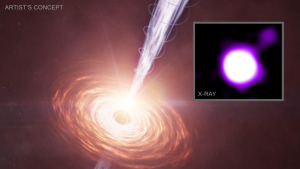
X-ray: NASA/CXC/CfA/J. Maithil et al.; Illustration: NASA/CXC/SAO/M. Weiss; Image Processing: NASA/CXC/SAO/N. Wolk
Most large galaxies have massive black holes in their core, and woe to the star, dust cloud, or other object that gets too close to their gravity wells. These giant monsters are capable of shredding stars and transforming any material into a luminous accretion disk rich in charged particles that can drive magnetic fields that stream high-energy particles in high-speed jets.
In our modern day, most supermassive blackholes lay dormant. They have already consumed all their easy meals. When the universe was young, however, food was plentiful and active galactic nuclei were common.
Astronomers sometimes refer to the era of active galaxies, when the universe was about 3 billion years old, as Cosmic Noon. While studying this epic, the Chandra X-ray observatory captured X-ray photons associated with high-energy electrons in Black Hole Jets.
This is not a gentle process – Cosmic Microwave Background photons can scatter off the high-speed electrons jetting out of black hole systems and transform that energy from motion into high-wavelength light – X-Ray light – that Chandra can see.
In a new paper in the Astrophysical Journal, researchers led by Jaya Maithil use new data processing algorithms to identify two systems with extremely long jets pointed almost directly at us, which are moving at nearly the speed of light. In one system, the jet is moving at 95-99% the speed of light, and in the other clocks in at 92-98% the speed of light. Their jets measure more than 300,000 light years from their galaxies’ cores.
These systems are dynamically changing their environment. Light from the accretion disk where they originate can push material away from the galactic core and irradiate the galactic core, ultimately starving the blackhole while also disrupting and/or irradiating solar systems trying to form in the blast zone. The jets can also push away material near the galaxy, and their ionizing light can set the remaining material aglow.
These are powerful and deadly systems, and it is safe to say that some dreamed of ancient civilizations were prevented from coming into existence by these jet-wielding active black holes.
Aren’t you glad they mostly existed early in the universe?
This research was funded by NASA and utilized both the NASA-funded Chandra X-ray observatory and the NSF-funded Very Large Array.
